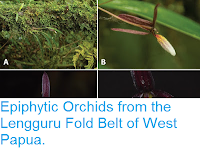Epidendroid Orchids, Epidendroideae, are the largest subfamily of
Orchids, with over 15 000 described species, more than all other Orchid
groups combined. The majority of these species are epiphytic (live on
other plants, typically in the canopy of rainforest trees), though
terrestrial forms are known. The group is found across the globe, with
the exception of the polar regions, the deserts of Africa, Arabia and
Australia, and the southern part of South America. The genus Coelogyne
contains about 200 species predominately found in South and Southeast
Asia, as well as on the islands of the Pacific as far east as Fiji and
Samoa.
In a paper published in the journal PhytoKeys on 12 October 2017, Bin Yang and Shi-Shun Zhou of the Southeast Asia Biodiversity Research Institute of the Chinese Academy of Sciences, and the Centre for Integrative Conservation at the Xishuangbanna Tropical Botanical Garden, Qiang Liu, also of the Southeast Asia Biodiversity Research Institute of the Chinese Academy of Sciences, and of the Gardening and Horticulture Department at the Xishuangbanna Tropical Botanical Garden, Kyaw Win Maung of the Forest Research Institute of the Ministry of Environmental Conservation and Forestry in Myanmar, Ren Li, also of the Southeast Asia Biodiversity Research Institute of the Chinese Academy of Sciences, and Rui-Chang Quan and Yun-Hong Tan, agian of the Southeast Asia Biodiversity Research Institute of the Chinese Academy of
Sciences, and the Centre for Integrative Conservation at the
Xishuangbanna Tropical Botanical Garden, describe a new species of Coelogyne from the Hponkanrazi Wildlife Sanctuary in Kachin State, Myanmar.
The new species is named Coelogyne magnifica, in reference to its large, attractive flowers. It is an epiphytic or lithophytic herb (small plant growing on other plants or exposed rocks) reaching 11-15 cm in height, producing clusters of large, fleshy, white flowers in April and May and fruit in June and July.
Coelogyne magnifica, wild specimen in flower. Yang et al. (2017).
Three populations of these Orchids were found, all growing within the Hponkanrazi Wildlife Sanctuary in Kachin State, at altitudes of about 2450 m. All locations were rather inaccessible, and showed no sign of any Human molestation, for which reason Yang et al. do not believe the species to be under any current conservation threat.
Coelogyne magnifica, illustrative drawing. Yunxi Zhu in Yang et al. (2017)..
See also...
Follow Sciency Thoughts on Facebook.








